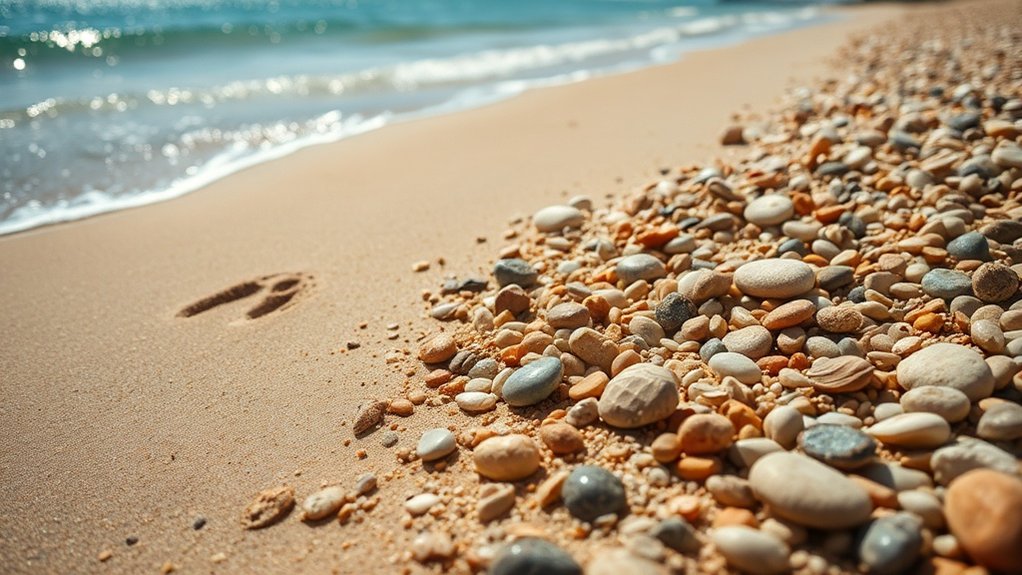When selecting aggregates for resin-bound gravel in coastal areas, prioritise properties like salt resistance, UV stability, and low porosity to ensure durability. A combination of fine and coarse aggregates is ideal for effective drainage and surface strength. Opt for angular shapes to enhance mechanical interlock, and choose colours that reflect natural coastal tones for aesthetic appeal. Pay careful attention to drainage and maintenance during installation to improve longevity against harsh coastal conditions. There’s plenty more to discover to achieve the best results.
Key Takeaways
- Choose aggregates with low porosity to withstand salt air, moisture, and UV exposure typical of coastal areas.
- Opt for a balanced mix of fine (1-3mm) and coarse (2-5mm) aggregates for effective drainage and strength.
- Use angular aggregates to improve mechanical interlock and slip resistance, especially in busy areas.
- Select aggregate colours that reflect natural coastal hues for a seamless blend with the environment.
- Regularly maintain the surface by sweeping and pressure washing to prevent clogging and maintain permeability.
Importance of Aggregate Properties for Coastal Resin-Bound Gravel
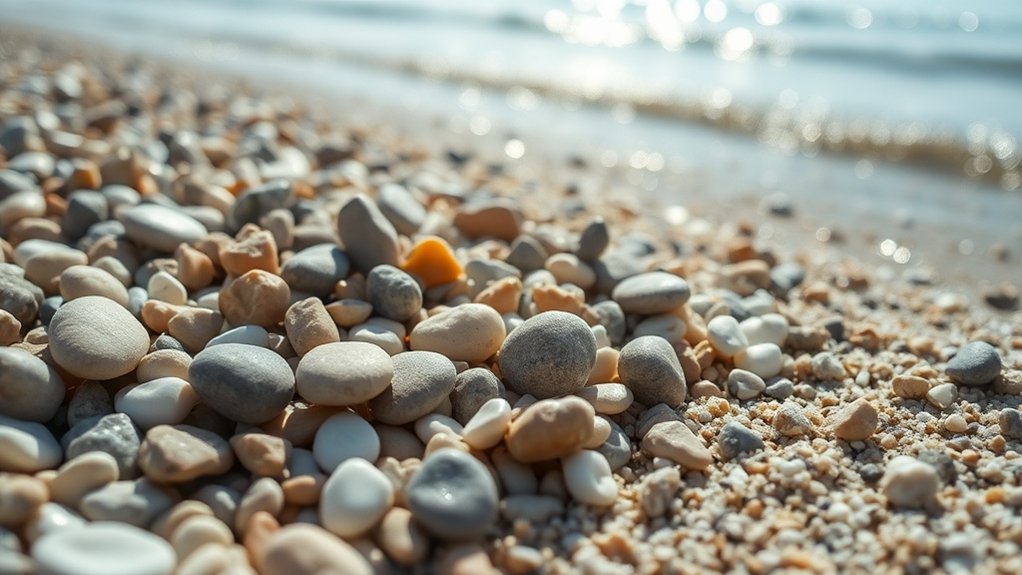
When choosing aggregates for coastal resin-bound gravel, it’s crucial to understand their properties. Focus on performance in coastal conditions—salt resistance, humidity tolerance, and chemical stability are key. Aggregates must endure the corrosive effects of salt air and water to ensure long-lasting durability. Given the high moisture levels typical of coastal areas, it’s important that aggregates maintain their structural integrity while facilitating effective drainage. Proper base preparation(for effective drainage) is crucial for effective drainage in both systems resin-bound gravel. UV resistance is also essential to prevent deterioration and maintain appearance. Additionally, the aggregates should be durable against sea spray and sand abrasion.
Selecting the Right Aggregate Size and Shape
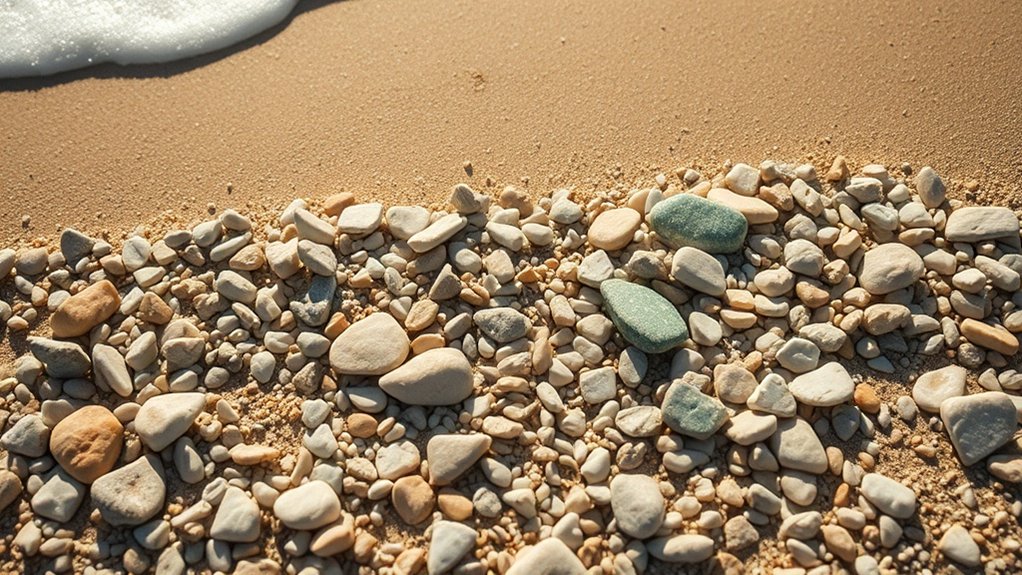
Choosing the right aggregate size and shape is crucial for optimal performance in resin-bound gravel applications, particularly in coastal areas.
Fine aggregates, usually under 4.75mm, create a smoother finish, while coarse aggregates, ranging from 9.5mm to 37.5mm, offer enhanced durability and texture. A combination of 1-3mm and 2-5mm aggregates strikes a balance between surface strength and visual appeal. Additionally, selecting aggregates with specific size distributions ensures that they meet the necessary requirements for stability and performance in resin-bound applications. Using washed, kiln-dried stones will further enhance material quality and ensure a strong bond with the resin.
Angular aggregates provide better mechanical interlock, improving slip resistance—essential for coastal settings—while rounded aggregates deliver a more comfortable walking surface.
When selecting aggregate colours, opt for blends that mimic natural coastal tones for both aesthetic and functional benefits. The right size and shape not only affect texture but also play a significant role in the long-term performance of the resin-bound surface.
Ensuring Proper Permeability and Water Management
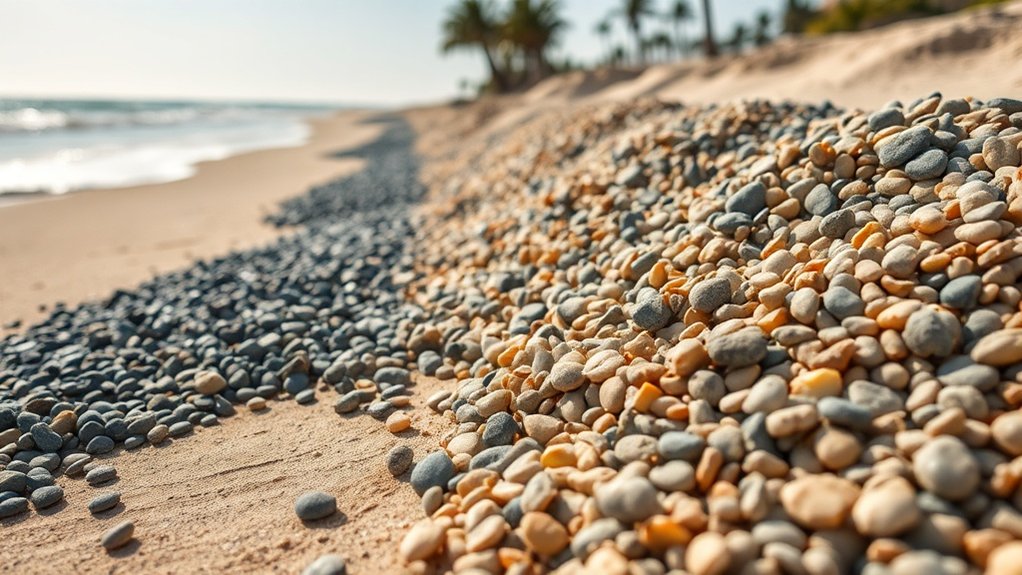
To ensure proper permeability and effective water management in resin-bound gravel, it’s crucial to choose the right aggregate size and shape. Suitable aggregate characteristics create micro-gaps that promote water infiltration while providing stability. Regular maintenance is vital to prevent clogging and to keep the system permeable over time. For instance, cleaning the surface with a pressure washer can help maintain its functionality and appearance. Additionally, using a high-quality resin binder in the mixture enhances the overall durability and performance of the driveway. By mimicking natural drainage patterns, resin-bound surfaces alleviate pressure on local drainage systems, making them ideal for areas prone to heavy rainfall.
Importance of Aggregate Size
The size of aggregates is crucial for ensuring proper drainage and effective water management in resin-bound gravel systems, especially in coastal areas. A balanced mix of 1–3mm and 2–5mm aggregates is ideal. This combination allows for sufficient porosity, enabling 90–95% of rainwater to infiltrate and reducing surface runoff.
Using larger aggregates over 6mm can lead to a rough surface and increased wear, while smaller aggregates under 1mm may clog the system and hinder drainage. Properly graded aggregates reduce void spaces, allowing water to pass through quickly, which is vital for resilience against coastal challenges.
Choosing the right aggregate size not only improves drainage but also enhances structural stability and longevity, especially in areas that experience tidal changes and heavy rainfall.
Maintenance for Permeability
To maintain the permeability of resin-bound gravel surfaces, it’s crucial to adopt a proactive maintenance routine to prevent clogging and sediment build-up.
Regular vacuuming is essential to remove debris and organic matter that can obstruct water flow. The cleaning frequency should be based on local conditions, especially in coastal regions where windblown sand is common.
Avoid using sand for traction in winter, as this can exacerbate clogging; instead, use suitable salts that won’t harm the aggregates.
Regularly inspect for moss or algae growth and address these promptly with gentle pressure washing.
In more severe cases, specialised cleaning or re-texturing of the surface may be necessary to ensure optimal permeability and prevent future issues.
Assessing Durability and Weather Resistance
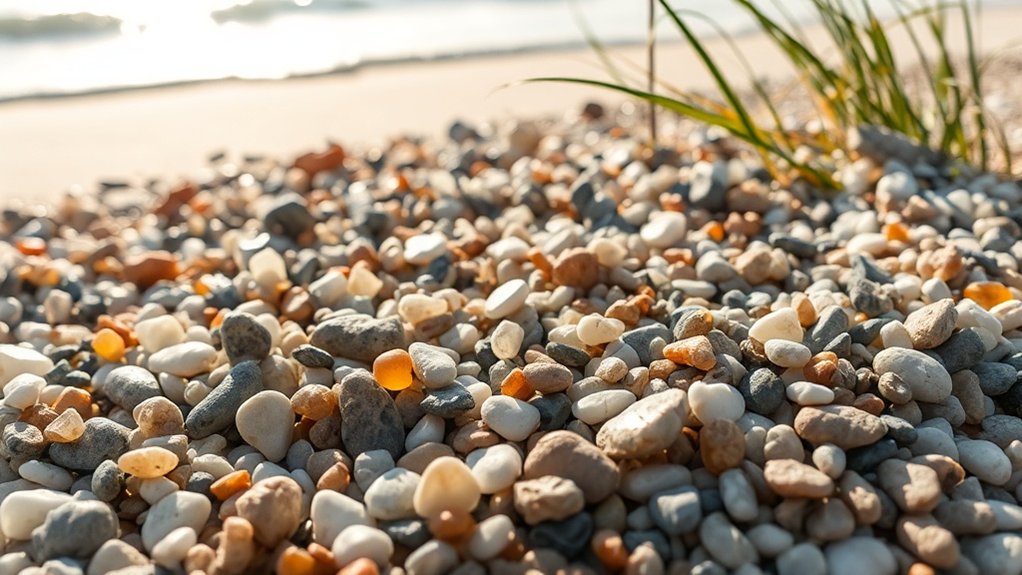
When assessing the durability and weather resistance of resin-bound gravel, it’s crucial to consider UV resistance, as this helps maintain colour and structural integrity over time.
Moisture absorption is another key factor; it can significantly affect the surface, impacting its lifespan and performance in challenging weather.
UV Resistance Importance
Understanding the importance of UV resistance in resin-bound gravel is crucial for ensuring durability and weather resilience. UV degradation can significantly reduce the lifespan of resin, leading to brittleness and surface damage.
High-quality UV-stable resins, such as DALTEX Performance UVR, are designed to resist yellowing and fading, preserving the visual appeal of the aggregate underneath. This is especially important in coastal areas where strong sunlight can accelerate damage.
Using UV-resistant materials not only extends the life of your surfaces but also minimises maintenance and enhances their appearance.
Regular inspections and cleaning can help maintain the protective qualities of UV-stable resins, ensuring your investment remains intact and functional for years.
When selecting aggregates, choose those that complement these resins for optimal results.
Moisture Absorption Effects
Moisture absorption significantly affects the durability and weather resistance of resin-bound gravel surfaces. In coastal regions, where humidity and salt spray are common, managing moisture in aggregates is crucial.
Here are some key considerations:
- Choose aggregates with low moisture content before installation to prevent future problems.
- Ensure aggregates are properly dried to maintain the effectiveness of the resin and its bond strength.
- Be cautious, as moisture-absorbent aggregates can cause surface degradation over time.
- Apply priming layers correctly to prevent adverse reactions between moisture and resin.
- Opt for aggregates with low porosity to improve resilience against coastal conditions.
Aesthetic Considerations for Coastal Environments
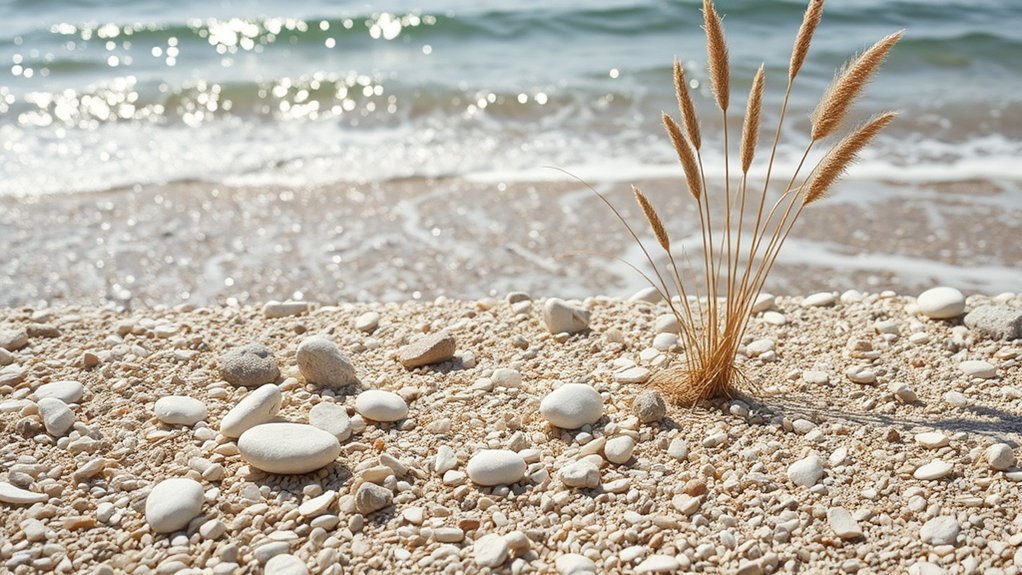
To create an appealing resin-bound gravel surface in coastal areas, it’s important to think about how colour and texture blend with the natural surroundings.
Use soft neutrals and whites to reflect sandy beaches, complemented by ocean blues and seafoam greens to mimic coastal waters. Consider subtle accent colours inspired by local vegetation to add interest without clashing with the coastline.
Choose aggregates that resemble natural textures like pebbles or shells, and opt for a matte finish to reduce glare from sunlight. Make sure the aggregate tones complement nearby buildings and landscaping for a harmonious look.
Also, think about how these aggregates will look when wet or dry to maintain consistency in changing coastal weather.
This careful planning will enhance the visual appeal and integration with the environment.
Installation Best Practices for Resin-Bound Gravel
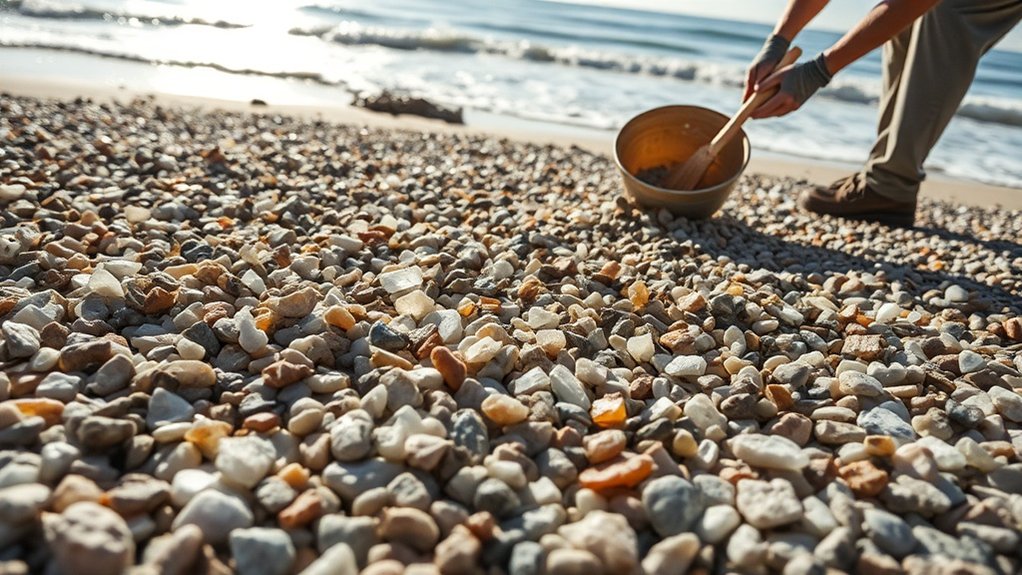
To create a durable and attractive resin-bound gravel surface in coastal areas, it’s essential to follow precise installation practices. Here’s a straightforward guide:
- Excavate to a depth of 150mm to establish a solid sub-base.
- Use compacted MOT Type 1 stone for added stability.
- Ensure the area is clean and dry to avoid any curing problems.
- Mix the resin and aggregates promptly, adhering to the recommended ratios.
- Apply the mixture evenly, ensuring a natural gradient for drainage.
Maintenance Strategies for Long-Lasting Surfaces
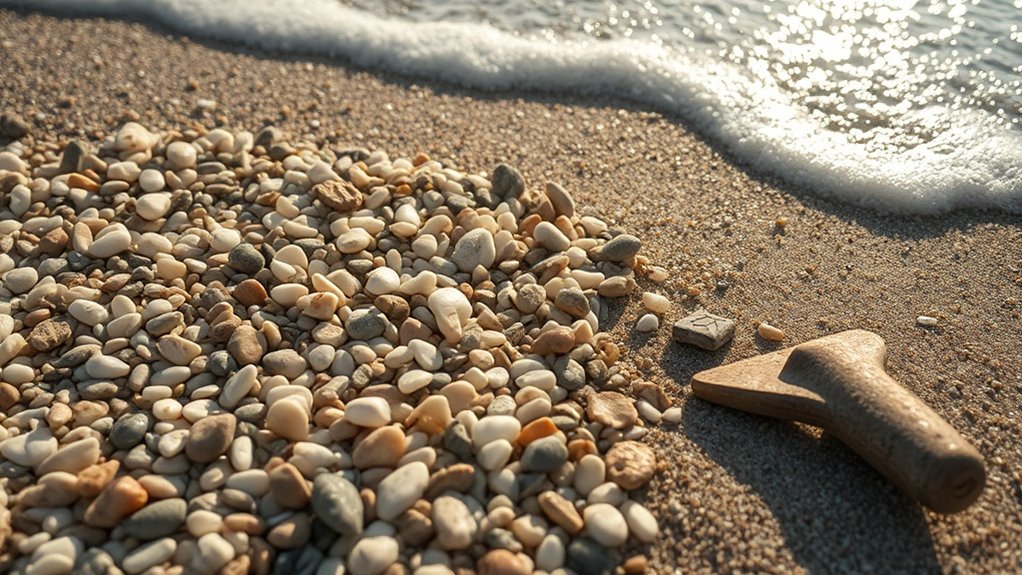
Maintaining resin-bound surfaces is vital for their longevity and performance. Start by regularly sweeping to remove debris and prevent moss.
For deeper cleaning, use jet washing, but keep the pressure low to avoid damaging the resin. Address spills promptly to prevent staining, and avoid placing heavy items on the surface to prevent damage.
Schedule seasonal inspections to catch and fix any issues early on. Choosing durable aggregates can improve resilience, and managing costs effectively helps you stay within budget.
Addressing Environmental Challenges in Coastal Areas
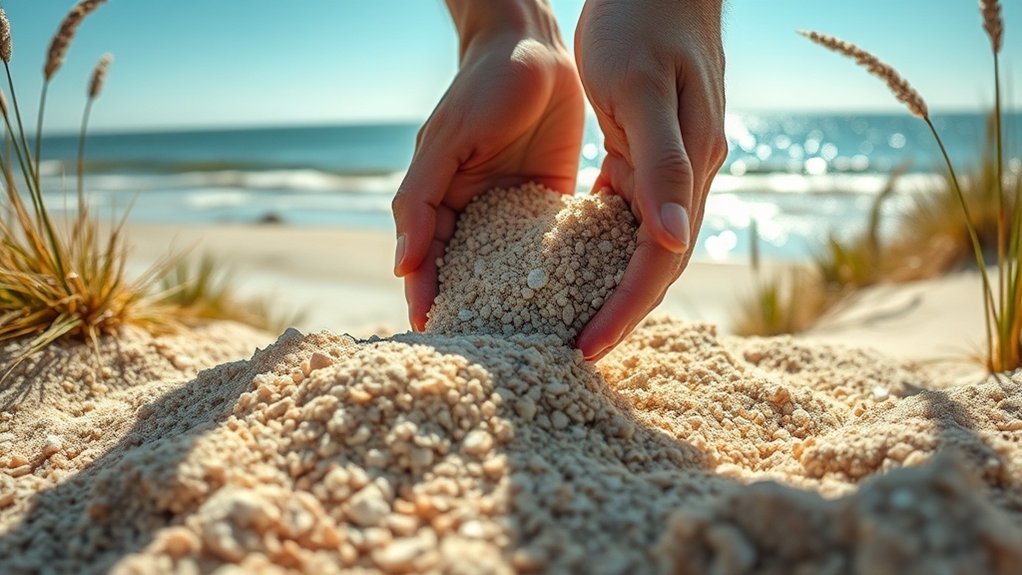
As coastal ecosystems face growing threats from climate change, pollution, and development, it’s crucial to address these challenges to safeguard both the environment and community resilience.
Here are key steps to consider:
- Enhance coastal conservation efforts to protect vital habitats.
- Implement pollution reduction strategies to tackle land-based contaminants.
- Promote sustainable development practices that limit ecological impact, such as eco-friendly building materials and energy-efficient designs.
- Restore natural barriers like mangroves and wetlands to help shield communities from storms.
- Educate local residents about the importance of preserving coastal ecosystems, illustrating with examples like the role of sea grass in supporting marine life.
Frequently Asked Questions
Can I Use Recycled Aggregates for Coastal Resin-Bound Gravel?
Yes, you can use recycled materials for coastal resin-bound gravel. Just ensure these materials have consistent grading and low absorption rates, as this will improve durability against coastal weathering and maintain performance in tough conditions.
How Do I Know if an Aggregate Is UV Stable?
To check if an aggregate is UV stable, perform testing by exposing it to UV light. Observe its colour and structure for consistency. Ensure it complies with industry standards for UV stability and has reliable certifications. For instance, if you’re using aggregates in outdoor settings, such as for driveways or patios, confirming their UV stability is crucial to prevent fading or degradation over time.
What Are the Best Aggregates for Slip Resistance?
Imagine strolling along a rocky beach; that’s how coastal aggregates like granite and basalt offer excellent slip resistance. Their angular textures improve grip, making them safe even in wet conditions. Choose wisely for long-lasting, slip-resistant surfaces.
Is There a Weight Limit for Vehicles on Resin-Bound Surfaces?
Yes, resin-bound surfaces generally support a maximum weight of 7.5 tonnes for most vehicles. This limit is important for maintaining the durability of the surface. Going over this weight can cause damage, so it’s crucial to consider vehicle weight when planning installations and usage. For example, a standard van or small lorry should be fine, but larger trucks may not be suitable.
How Can I Test Aggregate Hardness Before Purchasing?
Before purchasing aggregates, it’s wise to measure hardness using tests such as the Los Angeles Abrasion or Crushing Value tests. These methods may seem technical, but they’re straightforward and essential for ensuring quality. Think of it like checking the toughness of a stone before using it in your garden path.
Conclusion
Choosing the right aggregates for resin-bound gravel in coastal areas is essential for creating a durable surface that can withstand the harsh coastal conditions. Focus on aggregate properties, size, and durability to ensure effective functionality while blending in with the natural surroundings. For example, using angular aggregates can improve interlocking, providing better stability against strong winds and tides. With proper installation and maintenance, your surface can remain attractive and practical, complementing the coastal environment beautifully.
